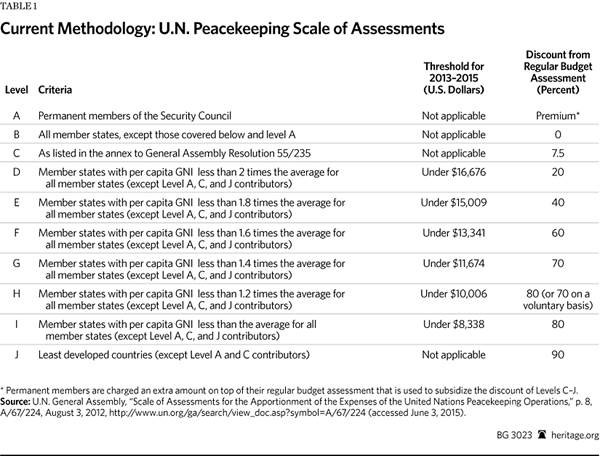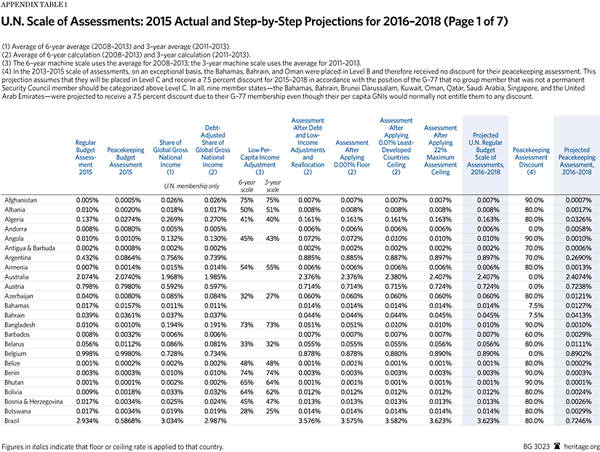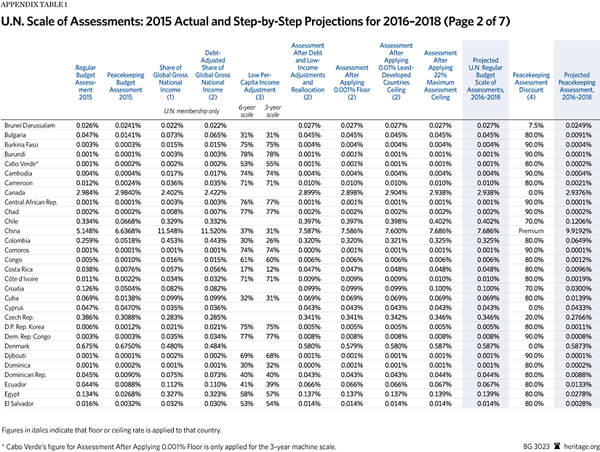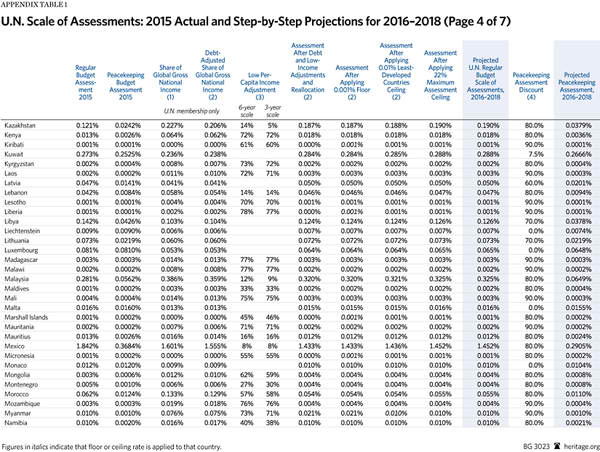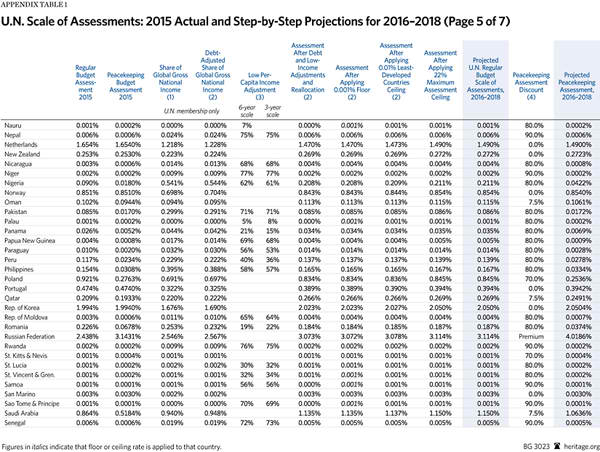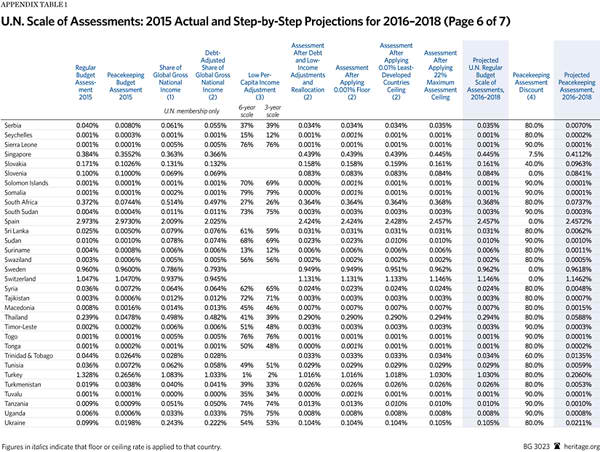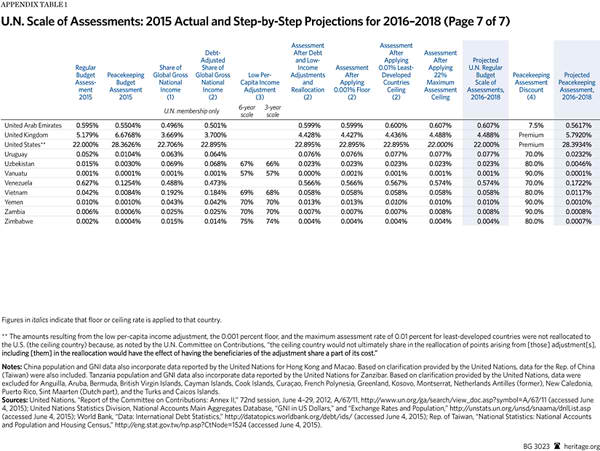Every three years, the member states of the United Nations negotiate how to apportion the expenses of the U.N. regular budget and the peacekeeping budget. These negotiations center on the U.N. “scale of assessments,” which assigns a specific percentage of the budgets to each member state, broadly based on its capacity to pay as calculated from its gross national income (GNI), modified by various factors.[1] The current system is based on a methodology that results in a handful of states footing the lion’s share of U.N. costs, with a disproportionately limited ability to shape the budget. This tilted system has undermined efforts to reform the U.N. to improve efficiency, transparency, and accountability.
The U.N. Committee on Contributions, the body of experts charged with analyzing the scale of assessments and its various criteria and elements, is meeting from June 1 to 26 to recommend adjustments for the General Assembly to consider in the fall. The U.S. has a representative on this committee. The Obama Administration should press strongly at this meeting and during the fall to adjust the scale of assessments for 2016–2018 to spread the financial burden more equitably among the member states and to give large contributors greater influence over budgetary decisions.
Unbalanced Allocation of Expenses
The United Nations consists of a complex system of organizations, funds, programs, offices, and other bodies. The “core” United Nations is generally considered to consist of the entities established in the U.N. Charter: the Security Council, the General Assembly, the Economic and Social Council, the International Court of Justice, the largely defunct Trusteeship Council, and the Secretariat. These bodies conduct various activities and oversee a wide array of committees, commissions, and working groups. To fund these activities, the U.N. has two main budgets:
- The regular budget. The U.N. regular budget funds the activities, staff, and basic infrastructure of the Secretariat and most U.N. non-peacekeeping activities. The regular budget also provides money (ranging from full funding to token amounts) to support the activities of various U.N. bodies, including the United Nations Human Rights Council, the United Nations Relief and Works Agency for Palestine Refugees in the Near East, and the United Nations Environment Program. It is a two-year (biennial) budget that is adjusted mid-period to account for new activities approved during the period. For instance, the current 2014–2015 U.N. regular budget was originally approved by the General Assembly at $5.538 billion, and was increased to $5.654 billion this past December.[2]
- The peacekeeping budget. The U.N. peacekeeping budget funds most of the peacekeeping missions established by the Security Council.[3] Unlike the regular budget, the peacekeeping budget is an annual budget from July 1 to June 30. The peacekeeping budget can fluctuate significantly as missions are established, expanded, contracted, or terminated. The originally approved peacekeeping budget from July 2014 to June 2015 was $7.06 billion.[4] The current estimate, as of March 31, 2015, is $8.47 billion.[5]
Article 17 of the U.N. Charter states that the “expenses of the Organization shall be borne by the Members as apportioned by the General Assembly.” Since the U.N.’s establishment in 1945, these expenses have been apportioned “broadly according to capacity to pay.”[6] This means that wealthier nations, based principally on the size of their economies and their per capita income level, and adjusted by other factors, are asked to pay larger shares of the budget than poorer nations. This was done in recognition of fiscal reality. The founders of the U.N. did not want U.N. membership to cause severe financial hardship. However, as evidenced from their actions in establishing a minimum assessment of 0.04 percent in 1946, they did not believe that membership should be costless or insignificant either, even though the original member states included very poor countries, such as Haiti.
Over the past six decades, the regular budget assessments provided by poor or small U.N. member states have steadily declined. For instance, the minimum assessment for the regular budget fell from 0.04 percent to 0.02 percent in 1974, to 0.01 percent in 1978, to the current minimum assessment of 0.001 percent adopted in 1998. Additional discounts have also been adopted to reduce the assessments of most nations, including a debt burden discount for countries under a specified income threshold, a low per capita income discount, and a maximum assessment of 0.01 percent for the nearly 50 least-developed countries.[7]
The peacekeeping assessment is based on the regular budget assessment. However, as shown in Table 1, over three-fourths of the U.N. membership receive reductions between 7.5 percent and 90 percent to their regular budget assessment (based on per capita income levels) to determine their peacekeeping assessment.
To accommodate these reductions, the minimum peacekeeping assessment was reduced even further below that of the regular budget to 0.0001 percent.[8] These reductions are then added to the assessments of the permanent members of the Security Council as a reflection of “their special responsibilities for the maintenance of peace and security.”[9]
The primary result of these adjustments is a shift of the costs of the organization away from the bulk of the membership to a relative handful of high-income nations, particularly the United States. As presented in Table 2, for the regular budget, the U.S. is assessed more than 176 other U.N. member states combined, and 22,000 times more than the least-assessed countries. These differences are even starker in dollar terms:
- The 35 countries charged the minimum assessment in 2015 will each pay only $28,269 in 2015 based on the current 2014–2015 regular budget.
- The 20 countries paying the minimum peacekeeping assessment of 0.0001 percent in 2015 will each be assessed approximately $8,470 under current budget estimates.
- By contrast, the U.S. is assessed 22 percent of the regular budget (approximately $622 million), and 28.3626 percent of the peacekeeping budget (approximately $2.402 billion).
In other words, the U.S. will be assessed approximately $3 billion this year, while the 20 least-assessed countries each will be assessed less than $37,000. Over 40 countries will be assessed less than $100,000 this year for the regular and peacekeeping budgets combined. As observed by U.N. expert Edward Luck, “Surely it should not cost a nation less to belong to the UN than an individual to go to college or to buy a car.”[10]
This disparity between budgetary authority and responsibility helps explain why so many member states are blasé about increases in the U.N. budget: The financial impact on them is minuscule. This undermines their incentives to fulfill their oversight role and seriously consider budgetary restraint. A long-term means for addressing this problem requires all member states to have financial skin in the game.
A Persistent Struggle
Since the first scale of assessments was proposed in 1946, the U.S. has objected to excessive reliance on a single member state for the budget, arguing for a maximum assessment level and, subsequently, lowering that maximum.[11] Reducing the U.S. assessment is a contentious issue because the scale of assessments is generally a zero-sum game—if America’s assessment is reduced, other member states must increase their own contributions.[12] Nonetheless, the U.S. succeeded in reducing its assessment for the regular budget in roughly a dozen incremental steps from a high of 39.84 percent in 1947. A maximum contribution level was established at one-third of the budget in the 1950s, and was steadily reduced to 25 percent in 1974.
Since the 1990s, the focus of the U.S. efforts has been to reduce its assessment for peacekeeping, which has outstripped the U.N. regular budget in size and resulted in an increasingly heavy financial burden on the permanent members of the Security Council, particularly the U.S.[13] As President Bill Clinton stated before the General Assembly in 1993, “[T]he U.N.’s operations must not only be adequately funded, but also fairly funded.... [O]ur rates should be reduced to reflect the rise of other nations that can now bear more of the financial burden.”[14]
In 1994, President Clinton signed P.L. 103–236, which capped U.S. contributions to U.N. peacekeeping at 25 percent.[15] The discrepancy between this cap and the amount that the U.N. assessed to the U.S. for peacekeeping led to a rapid accumulation of arrears in the 1990s.
This financial stress led the U.N. and the other member states to agree to lower the maximum contribution level for the regular budget assessment from 25 percent to 22 percent in 2001, which was a condition for U.S. payment of arrears under the 1999 Helms–Biden agreement.[16]
As part of the agreement, the U.N. also established a formal methodology for calculating the peacekeeping assessment that was to gradually reduce America’s peacekeeping assessment to 25 percent. Ambassador Richard Holbrooke, who brokered the deal, secured an immediate reduction from 30.2816 percent in 2000 to 28.134 percent in January 2001.[17] He testified that the “U.S. rate will continue to progressively decline, and we expect that it will reach 25 percent by roughly 2006 or 2007.”[18]
Congress accepted Holbrooke’s assurances in good faith and approved payment of the arrears. While Congress maintained the 25 percent cap, it approved periodic increases to avoid accumulating arrears while the U.N. lowered the U.S. assessment to 25 percent. As illustrated in Table 3, the U.S. peacekeeping assessment did decrease, albeit more slowly than Holbrooke predicted, with the U.S. share falling to less than 26 percent in 2009. In 2010, however, the U.S. assessment rose sharply in the 2010–2012 scales of assessment and again in the 2013–2015 scales of assessment. The U.S. assessment for the peacekeeping budget has risen to 28.3626 percent in 2015.[19] The difference between the 25 percent promised by Holbrooke and the current assessment is small in percentage terms, but has cost U.S. taxpayers hundreds of millions of dollars.
The experience of the past 25 years illustrates that financial leverage can be used as an incentive for the U.N. to change the U.S. assessment and, conversely, that accommodation encourages the U.N. to ignore U.S. calls for lower assessments. The U.S. policy of unilaterally imposing a 25 percent cap on its contributions to peacekeeping and making payment of arrears under Helms–Biden contingent on lower assessments was instrumental in getting the 22 percent regular budget cap and a commitment to lower peacekeeping assessments. The U.N. continued to lower the U.S. assessment when it believed that the U.S. was serious about withholding.
The U.S. sent the opposite signal by increasing the cap from 25 percent to 27.1 percent in 2009 and applying it retroactively through 2005 to allow payment of arrears accumulated during that period. The other U.N. member states interpreted this action as a weakening of U.S. resolve, and, unsurprisingly, increased the U.S. peacekeeping assessments in 2010 and again in 2013.
Under the current formula, and, as illustrated in the appendix, unless changes are made, U.S. peacekeeping assessments are likely to increase again in the 2016–2018 scale of assessments. Unless the U.S. insists that the U.N. establish a maximum peacekeeping assessment of 25 percent and follow through by refusing to pay above this level, it is very unlikely that it can reverse this trend.
Seven Steps for the U.S.
There are two compelling incentives for the U.S. to take a hard line on demanding more equitable distribution of the costs of U.N. activities. First, when a large number of countries pay de minimis amounts to the U.N. budgets, they have a similarly small incentive to ensure that those funds are used well. Second, Congress and the Administration have a responsibility to be prudent stewards of taxpayer dollars. The failure of the U.S. to secure a 25 percent cap on U.N. peacekeeping has cost the U.S. taxpayer over a billion dollars over the past decade. To address these issues, Congress and the Administration should work together to:
- Adjust the U.N. scale of assessment to ensure that even the lowest-assessed countries have a greater stake in financial decisions. An example would be to return the minimum regular budget assessment to 0.01 percent as it was before 1998, which would have the effect of increasing the minimum regular budget assessment, based on the 2014–2015 biennial budget, from roughly $28,000 per year to about $280,000 per year. To address the even greater disparity in the peacekeeping assessment, the U.S. should seek to increase the peacekeeping floor to 0.001 percent from the current 0.0001 percent. This would have the effect of increasing the minimum assessment, using the 2015 peacekeeping budget estimate as an illustration, from roughly $8,470 per year to about $84,700 per year. In addition, the 0.01 percent maximum regular budget assessment for least-developed countries should be eliminated, as it affects only a handful of countries that, with the exception of Equatorial Guinea, already benefit from the low-income adjustment. These changes would affect approximately 80 countries. While they would increase the financial obligations of some of these countries, the increase should be within the means of even the poorest sovereign nations.
- Enforce the 25 percent cap on America’s peacekeeping assessment. The U.S. should resume pressure on the U.N. to lower the U.S. peacekeeping assessment by withholding the difference between the U.S. peacekeeping assessment and the 25 percent cap, and making payment of the resulting arrears contingent on the U.N. establishing a maximum peacekeeping assessment of 25 percent.
- Establish minimum assessments for permanent members of the Security Council. The U.N. methodology currently states that the permanent members of the Security Council “consistent with their special responsibilities for the maintenance of peace and security, should be assessed at a higher rate than for the regular budget.”[ 20] However, there is a significant gap among the permanent members, with the U.S. being assessed more than the other four permanent members combined. The U.S. should propose that permanent members have a minimum peacekeeping assessment of 5 percent.[21] This minimum permanent member assessment should be used to offset the cost of the peacekeeping discount for those member states not receiving such discounts and the 25 percent peacekeeping cap.
- Adopt minimum assessments for non-permanent members of the Security Council. The “special responsibilities for the maintenance of peace and security” are not limited to the permanent members; they also apply to the non-permanent members whose votes are necessary for the council to act. The current non-permanent members and their 2015 peacekeeping assessments are: Angola (0.001 percent), Chad (0.0002 percent), Chile (0.0668 percent), Jordan (0.0044 percent), Lithuania (0.0219 percent), Malaysia (0.0562 percent), New Zealand (0.253 percent), Nigeria (0.018 percent); Spain (2.973 percent), and Venezuela (0.1254 percent). The U.S. should propose that non-permanent members be required to pay a minimum peacekeeping assessment of 1 percent for the extent of their tenure on the Security Council, which would affect every current non-permanent member except Spain.[22] This 1 percent minimum should be used to offset the cost of the peacekeeping discount for those member states not receiving such discounts and the 25 percent peacekeeping cap.
- Distribute the costs of the peacekeeping budget more equitably. Considering that the peacekeeping assessment is based on the regular budget for which many countries already receive significant discounts, the extent of additional peacekeeping discounts should be trimmed (as should the number of eligible countries) which currently apply to wealthy nations like the Czech Republic, Poland, Saudi Arabia, and Singapore. Only those countries with a per capita income level below the global average should be eligible for additional peacekeeping assessment discounts, which should be no more than 50 percent, with declining discounts as their per capita incomes approach the global average. Finally, the U.S. should also seek a change to bar permanent Security Council members like China from using the debt adjustment, low-income adjustment, or other regular budget scale-of-assessment discounts for the purposes of calculating their peacekeeping assessment.[23]
- Implement institutional changes to give major contributors more influence on U.N. budgetary decisions. Together, the top 17 contributors (those assessed more than 1 percent of the budget) are assessed more than 81 percent of the U.N. regular budget in 2015, but under U.N. rules, the 129 member states that contribute just over 1.5 percent can pass the budget over their objections. The U.S. should demand that U.N. budgetary decisions, in addition to approval by two-thirds of the member states, must also be approved by member states that collectively pay two-thirds of the regular budget assessments.
- Demand more transparency. The methodology for calculating the scale of assessments is needlessly complicated and opaque. Although the criteria and elements of the methodology are explained, critical details are not clear and the committee does not release the raw data used to determine the scale of assessments or its step-by-step calculations. The U.S. should demand that the committee explicitly and prominently publish the specific data used as well as the resulting calculations for establishing the respective assessment for each member state. In addition, the U.S. should propose replacing the current complicated 10-step process for deriving regular budget assessments with a more simplified system, such as that used for the peacekeeping assessment.
Conclusion
Congress and the Obama Administration have both expressed a desire for the United Nations to be more transparent and accountable and to use its resources more effectively. To accomplish this, U.N. budgetary decision making must be linked to financial responsibilities, the assessment process must be simpler and more transparent, and the disparity in apportionment must be lessened. Major donors must have a greater say in budgetary decisions, and smaller donors must assume financial responsibilities that lead them to make budgetary decisions with the seriousness they merit. The chance to reform the U.N. assessment system arises only once every three years: 2015 is one of those years, and the Obama Administration should not let this opportunity slip away.
—Brett D. Schaefer is Jay Kingham Senior Research Fellow in International Regulatory Affairs in the Margaret Thatcher Center for Freedom, a division of the Kathryn and Shelby Cullom Davis Institute for International Studies, at The Heritage Foundation. He is editor of ConUNdrum: The Limits of the United Nations and the Search for Alternatives (Rowman & Littlefield Publishers, 2009).
Appendix
